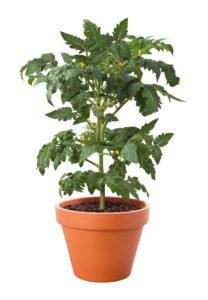Q. I’ve laid bark over landscape fabric for weed control following the instructions on the packaging. After four days, I was very surprised to find weeds growing right through the material. How do I get rid of the weeds? What can I do to prevent this from happening again?
A. To be effective, the bark or any other type of mulch should be at least two inches thick for weed control. The combination of the fabric and the mulch prevents light from reaching the soil. Without a light source, the dormant weed seeds can’t germinate. In the past, black plastic was used, however it did not allow the soil to breathe. Moisture was trapped under the barrier. Plants suffered from root rot from the excessive moisture. To correct the current situation, I’d spray the unwanted vegetation with Round Up and add additional mulch to prevent others from germinating. Many people believe that this will prevent weeds from ever being a problem again in this area. They are sadly mistaken when the weeds return. The landscape fabric will prevent only those weed seeds from germinating that is under it. It isn’t effective controlling any weed seeds above the barrier. Weed seeds move from area to area by the wind. As the hills turn brown, the seeds produce by the annual grasses and other plants are transported to new areas. Bark or any other mulch stored in open bins and delivered in bulk are more likely to have weed seeds than those packaged in bags. Over time the bark breaks down and become fine particles. It’s a perfect medium for seeds to sprouts and grow. Monterey Weed Stopper is a pre-emergent herbicide that sets up a chemical barrier that kills the weed seeds before they germinate. It’s too late to apply it once you see any growth. To keep the area weed free, be sure to follow the instructions on the label and don’t cultivate the area. If you do, you’ll have to reapply the material, as the barrier is broken.
Q. I have two tomato plants growing in large pots. They are doing well, in fact you can almost watch them grow. But, I’m a bit concerned because they are so very bushy. Should I strip some of the growth off or just let them continue on?
 A. It is important for tomatoes to be bushy with lots of leaves. The foliage cover is a type of natural sun block protecting the ripening tomatoes from sunburn. Sunburn is a tan/beige spot that forms on the south and southwest side of the fruits. But, you can have too much of a good thing. I’d selectively thin out the inside, secondary shoots that forms were a leaf connects to a stem. The center of the plants become crowded and dense as they mature, especially when you’re using a tomato cage. This will let in more light and increases the air circulation throughout the plant keeping the inside foliage from turning brown. I’d repeat this as necessary. You should also be on the lookout for Tomato Hornworm. They like to hide out in the center of the plant and eat their way outward. When caught early you can just pick them off or spray with BT or Captain Jack Dead Bug Brew.
A. It is important for tomatoes to be bushy with lots of leaves. The foliage cover is a type of natural sun block protecting the ripening tomatoes from sunburn. Sunburn is a tan/beige spot that forms on the south and southwest side of the fruits. But, you can have too much of a good thing. I’d selectively thin out the inside, secondary shoots that forms were a leaf connects to a stem. The center of the plants become crowded and dense as they mature, especially when you’re using a tomato cage. This will let in more light and increases the air circulation throughout the plant keeping the inside foliage from turning brown. I’d repeat this as necessary. You should also be on the lookout for Tomato Hornworm. They like to hide out in the center of the plant and eat their way outward. When caught early you can just pick them off or spray with BT or Captain Jack Dead Bug Brew.
Q. I have several fruit trees; orange, cherry and plum, planted on a slope. They all have a basin but the water seems to run out before it sinks into the ground. How can I get the water to penetrate faster?
A. Watering basins are a must today with the ongoing water restrictions. With plants planted on a slope, they should be six to eight inches high on the downside to form a sufficient watering basin. A soil surfactant such as EZ Wet from Grow More, aids or increases the percolation rate, preventing erosion and water run off. EZ Wet makes water “better” at doing its job. It reduces water’s surface tension so it penetrates directly into the root zone, hydrating plants more effectively. It’s applied directly to the watering basin of trees and shrubs. For moisture retention, I’d spread a three inch layer of mulch in the basin and beyond. The cherry and plum are watered every three weeks while the orange is watered more frequently. Instead of using an irrigation system, I’d hand water your trees to make every drop count. The other application is with containers of Japanese Maples, Citrus, Roses, Camellias, and other ornamental plants as it prevents the water from rolling around the root ball and down and out the sides of the container. Soil surfactants are not new as they have been around of decades. They were widely used in previous drought periods. EZ Wet should be applied every other month through November.
Leave a Reply